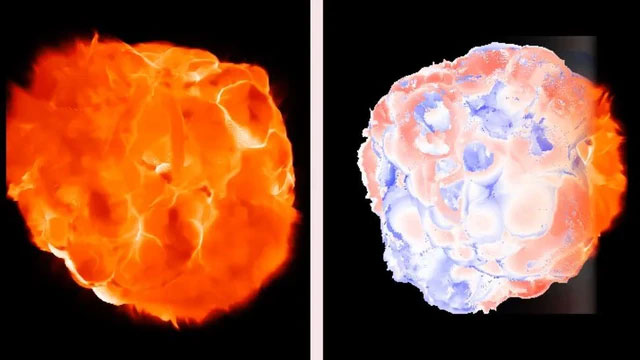The 'red monster' that Sima Qian mentioned caused illusions on Earth?
Not only is it huge, bright, spooky and always threatening to explode, the "monster" Betelgeuse may also create illusions before the eyes of Earthlings .
Recent observations of Betelgeuse - a super red monster star in the constellation Orion - have shown it to be spinning at an absurdly fast rate. But a new study from the Max Planck Institute for Astrophysics (MPA - Germany) suggests we may be seeing a mirage.
The surface of an object that has fascinated astronomers for more than 2,000 years may be boiling, new analysis suggests.

The Betelgeuse monster may be seething and distorted in the final stages of its life - (Photo: MPA).
According to Live Science, simulations from multiple images of Betelgeuse show signs of convection dominating its surface . So its surface could look like bubbling boiling water.
At a distance of 500-600 light years, this boiling has created an illusion that makes astronomers think it is rotating, circling at an absurdly fast rate compared to what such large objects can do.
Astronomers have yet to fully explain this surface seething, but it could be one of the signs of its death throes.
With a diameter of more than 1 billion kilometers, Betelgeuse is more than 1,000 times larger than our Sun and is one of the largest known stars.
It also attracts attention because it often appears and disappears in the sky. Not to mention, observations from ancient times to the present show that this monster has changed color.
According to documents from the Chinese scholar Sima Qian 2,100 years ago, Betelgeuse - as the ancient Chinese called it - at that time was bright yellow, not red like another famous star, Antares in the constellation Scorpio.
One hundred years later, the Roman scholar Hyginus described Betelgeuse as having a yellow-orange color like Saturn.
By the 16th century, Danish astronomer Tycho Brahe described Betelgeuse as being redder than Antares at that time. And today, it is a red supergiant star.
This discoloration suggests that Betelgeuse is entering the final stages of "red giant" status , a state in which dying stars lose energy.
Betelgeuse could explode at any moment with enough light to light up Earth's night sky, before collapsing into a smaller object, possibly a neutron star, since it is a giant star.
Betelgeuse has surprised astronomers many times by suddenly dimming, leading people to think it was about to explode. However, it is still there, very red. The dimming may just be an illusion created by some object or by gas and dust being ejected by the star itself.
Coupled with mirages from its possibly seething surface, Betelgeuse promises to continue to fascinate and perplex astronomers for a long time.
- Decoding the 'heartbeat' of the cosmic monster described by Sima Qian
- Visual illusions make you
- How many colors do you see in this picture?
- 18 optical illusions make you crazy
- Beam of hypnotic illusions that move makes you
- A 375-million-year-old sea monster that grows legs reveals the secret to changing the earth
- Roll on all kinds of visual illusions that cheat the brain
- 10 most famous aquatic monsters of all time
- The truth behind the legendary Kraken monster picture found on Google Earth
- The reason people see ghosts
- Discovery of space object powerful enough to tear apart the Earth
- Mysterious skinhead monster in Japanese legend
 Van Allen's belt and evidence that the Apollo 11 mission to the Moon was myth
Van Allen's belt and evidence that the Apollo 11 mission to the Moon was myth The levels of civilization in the universe (Kardashev scale)
The levels of civilization in the universe (Kardashev scale) Today Mars, the sun and the Earth are aligned
Today Mars, the sun and the Earth are aligned The Amazon owner announced a secret plan to build a space base for thousands of people
The Amazon owner announced a secret plan to build a space base for thousands of people